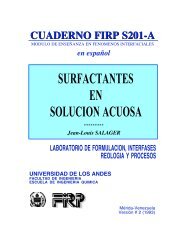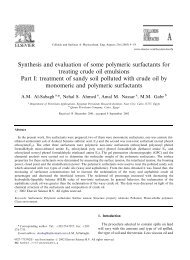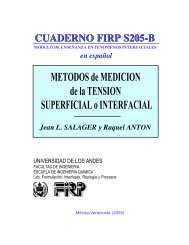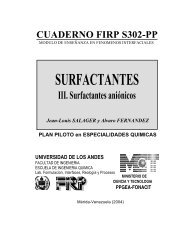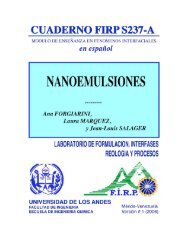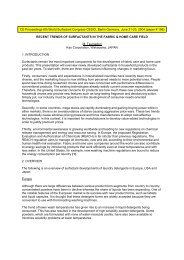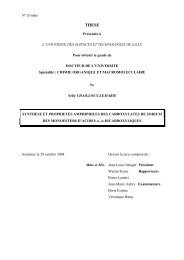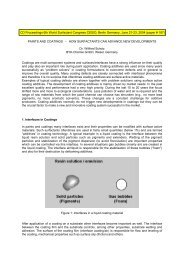Solubilization-emulsification mechanisms of detergency
Solubilization-emulsification mechanisms of detergency
Solubilization-emulsification mechanisms of detergency
You also want an ePaper? Increase the reach of your titles
YUMPU automatically turns print PDFs into web optimized ePapers that Google loves.
C.A. Miller and K.H. Raney/Colloids Surfaces A: Physicochem. Eng. Aspects 74 (1993) 169-215 179<br />
solubilize only small amounts <strong>of</strong> the oil phase.<br />
Note that solubilization <strong>of</strong> triglyceride in the<br />
lamellar liquid crystalline phase is also low.<br />
Behavior <strong>of</strong> the W + D' + O three-phase<br />
triangle has been studied as a function <strong>of</strong><br />
temperature for pure non-ionic surfactants and<br />
triolein. Figure 9 shows the results for C12E3<br />
[48], a lipophilic surfactant that is already above<br />
its cloud point at 0ºC, well below the<br />
experimental temperature range. The surfactant<br />
content <strong>of</strong> the D' phase increases rapidly with<br />
temperature, the same as for the L3 phase in<br />
binary surfactant-water systems, but<br />
solubilization <strong>of</strong> triolein remains low. The<br />
solubility <strong>of</strong> surfactant in the triolein phase is<br />
substantial - more than 10% by volume even at<br />
the lowest temperature studied (30.5ºC) - and<br />
increases with temperature. For comparison, we<br />
note that the solubility <strong>of</strong> C12E3 in excess<br />
n-hexadecane in equilibrium with<br />
microemulsions at 30ºC is about 3% by volume<br />
(see Fig. 7).<br />
At about 40ºC the rate <strong>of</strong> increase with<br />
temperature <strong>of</strong> surfactant solubility in the<br />
triolein phase increases significantly. Simultaneously,<br />
water solubilization in this phase,<br />
previously rather low, rises dramatically. Such<br />
formation <strong>of</strong> water-in-oil microemulsions is one<br />
way the system can depart at high temperatures<br />
from the behavior shown in Fig. 8.<br />
Another way is illustrated in Fig. 10 by the<br />
Fig. 9. The W + D' + 0 region at several temperatures<br />
in the C12E3-water-triolein system [48].<br />
Fig. 10. The W + D' + O and W + D + O regions at<br />
several temperatures in the C 12E 5-water-triolein<br />
system [48].<br />
corresponding C 12E 5 diagram [48]. Just above<br />
64ºC a phase transformation occurs, and at<br />
higher temperatures the diagram shows a new W<br />
+ D + O three-phase region instead <strong>of</strong> the W +<br />
D' + O region. The D phase is able to solubilize<br />
considerable triolein and is thus more favorable<br />
for <strong>detergency</strong> than D' if it forms as an<br />
intermediate phase during washing. According<br />
to Fig. 10, the composition <strong>of</strong> the D phase shifts<br />
to become richer in oil with increasing<br />
temperature in a manner similar to that seen for<br />
microemulsion systems [47] although the<br />
surfactant concentration <strong>of</strong> about 40% is well<br />
above that observed in typical microemulsions.<br />
Details <strong>of</strong> the phase behavior in the temperature<br />
region where the D phase first appears,<br />
including the existence <strong>of</strong> two four-phase<br />
regions at two closely spaced temperatures, are<br />
given for another system by Kunieda and<br />
Haishima [50].<br />
As indicated above, the inability <strong>of</strong> the<br />
hydrocarbon chain region <strong>of</strong> the surfactant films<br />
to incorporate the large triglyceride molecules is<br />
the chief reason for the poor solubilization.<br />
Similar poor solubilization and phase behavior<br />
have been seen in systems containing the<br />
anionic surfactant Aerosol OT, hydrocarbons<br />
with chain lengths <strong>of</strong> twelve and above, and<br />
NaCl brine [26]. Recently, Binks [51] has<br />
investigated further the phase behavior <strong>of</strong> some<br />
<strong>of</strong> these systems.<br />
If the surfactant films were made more flexi-




